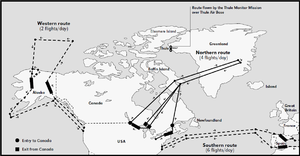
Back Operation Chrome Dome Danish Chrome Dome German Operación Chrome Dome Spanish Operaatio Chrome Dome Finnish Opération Chrome Dome French Operazione Chrome Dome Italian 크롬 돔 작전 Korean Operasjon Chrome Dome NB Операция «Хромированный купол» Russian Операція «Хромований купол» Ukrainian


Operation Chrome Dome was a United States Air Force Cold War-era mission from 1961 to 1968 in which B-52 strategic bomber aircraft armed with thermonuclear weapons remained on continuous airborne alert, flying routes that put them in positions to attack targets in the Soviet Union if they were ordered to do so. The exact routes varied by year, but in general there were routes that went to positions over the Canadian arctic, Alaska, Greenland, and the Mediterranean Sea. Many American Air Force bases in the 1960s allocated at least one bomber crew to "Chrome Dome" duty on a regular basis, and many other bases, including foreign bases, were involved in the refueling operations. Over the years the mission involved overflights of American, Canadian, Danish (Greenland), and Spanish territory, among others. The goal of "Chrome Dome" was to keep a number of nuclear-armed aircraft in a position to help guaranteed nuclear retaliation against the Soviet Union in the event that the latter was somehow able to destroy the majority of US nuclear weapons still on the ground, while also ensuring that Strategic Air Command bomber crews had experience with airborne alert procedures so that, in the event of heightened concern, the number of patrolling bombers could be increased dramatically. Several high-profile nuclear accidents were associated with the "Chrome Dome" program, including the accidental release of nuclear weapons on foreign territory, and it was shut down in the wake of one such accident in 1968.[1]
- ^ Croddy, Eric; Wirtz, James J. (2005). Weapons of Mass Destruction. ABC-CLIO. ISBN 1-85109-490-3.
The U.S. alert operation, code-named Chrome Dome, was a realistic training mission